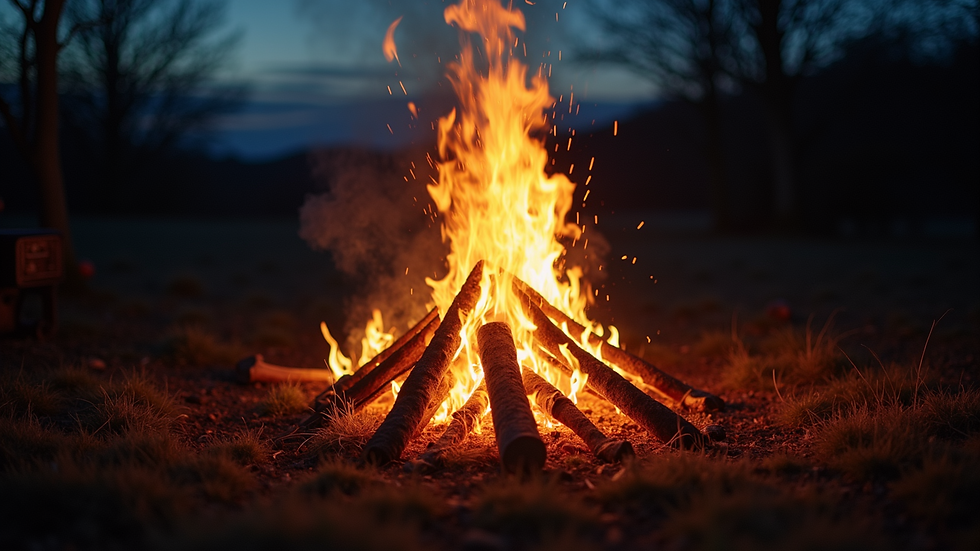The Sacred Flames of Beltane: Traditions and Rituals That Transcend Time
- koadofthecrossroad
- Apr 28
- 3 min read
Beltane, celebrated on May 1st, is much more than a seasonal marker; it is a vibrant festival rooted in ancient Celtic traditions. This festival signifies the arrival of summer, a time of growth, fertility, and vibrant life after the harsh winter months. Although modern interpretations may differ from ancient practices, many customs still resonate today. They reflect our deep connection to nature, spirituality, and the cycles of life.
Historical Significance of Beltane
Beltane was historically significant, especially for farmers and herders. During this time, it was common for farmers in Ireland and Scotland to drive their cattle through bonfire flames. This act was believed to protect the animals, ensuring their health and fertility for the upcoming year. Many farmers participated in this tradition, viewing it as essential for successful farming.
The bonfire itself carried immense importance in Celtic culture. It was traditionally ignited using nine pieces of wood, sourced from nine different tree species, and cut by nine men. This practice highlighted the communal spirit of Beltane, creating a bond between individuals and the land. The act of gathering for this purpose reinforced a community identity, with the fire symbolizing renewal and connection.
The Rituals of the Beltane Bonfire
In Wales, one unique tradition added layers to Beltane's bonfire rituals. Individuals who collected sticks for the fire avoided carrying iron objects, as it was believed that iron would anger fairies and disrupt the festival's energy. This illustrates how embedded folklore shaped the observances of Beltane, influencing behavior in practical ways.
Before lighting the sacred bonfire, all other fires in the area were extinguished. This act symbolized cleansing the old to welcome the new. Druids, the ancient priestly class of Celtic society, would chant over the flames, merging their voices with the fire's crackling sounds, invoking blessings and protection for the community.

Fire and Its Symbolic Meanings
An intriguing, albeit grim, custom involved offering the skull and bones of horses into the bonfire. This ritual was intended to magically transfer the horse's strength to livestock, showcasing the Celts' respect for animals and their vital role in survival. Historical texts indicate that this practice was observed across multiple regions, emphasizing its importance.
In Scotland, the tradition of the Beltane cake emerged. On the eve of May, families would bake a simple cake, intentionally slightly burnt on one edge. Each family member would blindly select a piece. The one who chose the burned piece, known as the "Beltane carline," had to leap three times over the bonfire, believed to bestow vitality and protection for the coming year.
Scandinavian Parallel Traditions
Beltane's fire festivals extended beyond Celtic borders. In Scandinavia, a similar celebration known as "Balder’s balefire" involved a man, chosen by lot, jumping through flames to represent the dying God. This dramatic leap further emphasized the themes of rebirth and renewal. Effigies of Nordic deities were often cast into the flames, highlighting the connection to the divine and the cycle of life and death.
The Transition to Christian Influence
As Christianity spread, the church sought to incorporate ancient Pagan practices into its beliefs. Many Beltane festivities were replaced by church services, including a procession led by priests to bless soil and crops. This transition was not a complete severance from tradition; it merged sacred practices with evolving spiritual beliefs.
Even the sick were included in these rituals. They would be carried around the bonfire, with the belief that the community’s collective energy would enhance the effectiveness of the blessings. This tradition reinforces a core belief found across many cultures: that coming together as a community can yield powerful results.
Modern Celebrations and Symbolic Leaps
Today, Beltane remains vibrant, particularly among neopagan communities. Couples jump over the bonfire for blessings on their marriages, mirroring ancient beliefs that June is a favorable month for weddings, connected to sacred unions celebrated in May.
The name "Beltane" translates to "bright fire," capturing the festival's essence of warmth, light, and renewal. Jumping over the fire teaches communities about trust, love, and commitment, maintaining its relevance even in contemporary contexts.
Honoring the Flames of the Past
The sacred flames of Beltane weave together history, rituals, and community in a way that transcends time. As we reflect on the past, the vibrant traditions of this festival highlight themes of renewal and our interconnectedness with nature.
Beltane reminds us that despite changes in belief systems and society, our fundamental connections to the earth and each other remain constant. Whether gathered around a bonfire or reflecting on its significance, the spirit of Beltane continues to illuminate our paths forward, nurturing a sense of belonging and reverence.
As summer arrives this May, consider how you can honor these age-old customs while integrating your interpretations. Keep the flames of Beltane alive in your heart and community, celebrating both tradition and renewal.



Comments